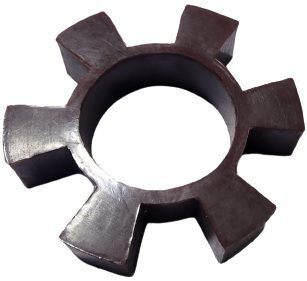
Spider Coupling
A spider coupling, also known as a jaw coupling or elastomeric coupling, is a type of flexible coupling used in machinery to connect two shafts while allowing for a certain degree of misalignment and absorbing shock and vibration.
Spider couplings consist of three main components: two hubs, typically with jaws or curved fingers, and an elastomeric spider (the flexible element) that fits between the hubs. These couplings are designed to transmit torque and accommodate small angular and parallel misalignments between the shafts. Here are some key features and applications of spider couplings:
Key Features:
Flexible Element: The elastomeric spider, often made from materials like polyurethane or rubber, provides flexibility, allowing for misalignment between connected shafts.
Absorption of Shock and Vibration: Spider couplings can dampen and absorb shock and vibration, which helps protect sensitive components in a machinery system and extends the equipment's life.
Easy Installation: These couplings are easy to install and require no lubrication, making them user-friendly and low maintenance.
High Torque Transmission: Spider couplings are capable of transmitting high torques, making them suitable for various applications.
Cost-Effective: They are cost-effective and widely used in a range of industries.
Applications:
Industrial Machinery: Spider couplings are used in various industrial applications, including conveyors, pumps, compressors, and fans, to connect drive shafts and transmit power.
Automotive: In vehicles, spider couplings are used in power transmission systems to connect the engine to the transmission and wheels, allowing for some degree of misalignment while transmitting torque.
Agricultural Machinery: In farming equipment such as tractors, where the machinery experiences a significant amount of shock and vibration, spider couplings are used in power transmission systems.
Pumps and Compressors: These couplings are used in pumps and compressors to connect the motor to the pump or compressor shaft, accommodating misalignment and dampening vibrations.
Printing and Packaging: In printing and packaging machinery, where precision is crucial, spider couplings are used to connect the drive components and absorb vibrations.
Marine: In marine applications, such as boat propellers, where the equipment is exposed to a harsh environment and varying loads.
Material Handling: In material handling equipment, such as conveyor belts, where spider couplings help absorb the shock and impact of transported materials.
Textile Industry: Spider couplings are used in textile machinery to connect various components in the production process.
Petrochemical Industry: In petrochemical and processing equipment, where spider couplings help transmit power and dampen vibrations.
The choice of spider coupling depends on the specific requirements of the application, such as torque capacity, misalignment tolerance, and environmental conditions. Proper maintenance and regular inspection are essential to ensure the continued performance of the coupling and to replace the elastomeric spider when necessary.
